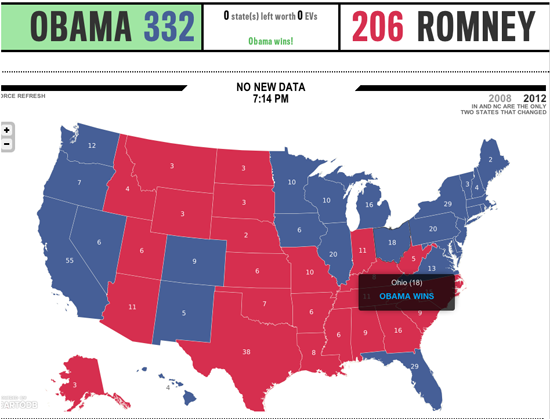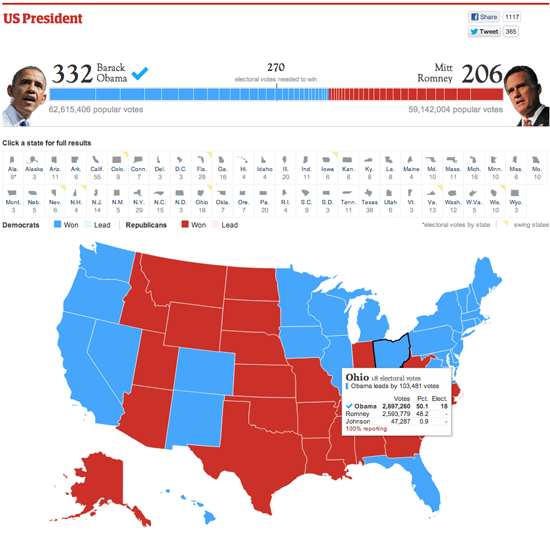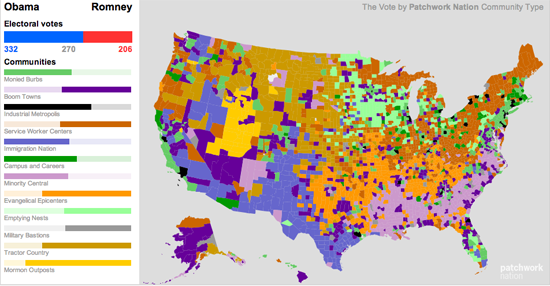Sign up for the daily CJR newsletter.
Data journalism and information visualization is a burgeoning field. Every week, Between the Spreadsheets will analyze, interrogate, and explore emerging work in this area. Between the Spreadsheets is brought to you by CJR and Columbia’s Tow Center for Digital Journalism.
As CJR’s Meta Newsroom showed, a glut of media outlets incorporated digital innovation into their reporting during the recent election. One resurfaced over and again: the map. For the outlets just dipping their toes into the data journalism sea, maps presented a relatively easy opportunity to make an interactive. For the heavyweights, it was a chance to wade in much deeper.
The Daily Beast kept things simple with a straightforward blue and red map that updated as real-time data came through with the state-by-state results. Above the map, a counter tracked overall totals for Obama and Romney. The number of electoral college votes assigned to each state were marked directly on the map.
The Beast used CartoDB to produce its map. The election was a boon for the new mapping software company, which was also powering the Wall Street Journal‘s coverage. These real-time results maps show that online news environments have become, like television, a space to ‘watch’ results — be that election outcomes or sporting scores.
The Beast’s map may appear simple, but it does something many others neglected: It includes an option to toggle between current results and those from four years ago. It’s nothing special, but it does add a little context and serves as a visual cue for users to engage with this map beyond just getting information about who won what state in 2012.
The Chicago Tribune‘s map was similar to the Beast’s: results across the top and a red and blue map beneath. Hovering over each state reveals a box with more details. That information is also displayed beneath the map itself in a table breakdown by number of votes for each candidate and their percentages.
The Guardian US also focused on state breakdowns, taking this reporting detail a step further and devoting pages to each state. As well as voting numbers and percentages, there are results for Congress and for gubernatorial races. Much like its other interactives, the Guardian‘s piece functions as a longer-living resource. It goes into more detail so it has a longer shelf life than just the night of the election. Storing up all this data benefits the media outlet as well: Come the next election, it will have a lot of data already at its fingertips to make even more involved interactives.
It’s WNYC’s map that really looked different from the rest. While their election map did have the same blue and red color-coding (albeit in a horrendously bright hue); it also contained demographic data. The map went beyond the simple results to draw correlations about why the results were what they were. Clicking on a state gave a breakdown by county of the different types of communities contained within it. Although the medley of colors used did create a patchwork effect, the color palette left a lot to be desired. Aesthetics to one side, this piece was spot on in giving the bigger picture; framing the election results within a wider demographic context.
These media outlets displayed great feats of digital dexterity in their online mapping on election night, showing that the networks were not the only place to view election result in real-time. That being said, I think NBC’s ice-rink map — a map of the US carved out in Rockefeller Plaza onto which presenters laid the corresponding colors to the states as the elections were called – in all its low-tech glory, was by far the most entertaining way to see this election mapped out.
Has America ever needed a media defender more than now? Help us by joining CJR today.









